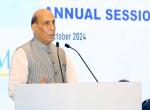The highly disturbed and extremely volatile security environment in India’s neighbourhood underlines the need for India to substantially strengthen its national security apparatus with a range of strategic and tactical battlefield missiles featuring cutting edge technologies. In particular, the combative mood of the China over territorial and boundary disputes with India has highlighted the need to deploy long range ballistic missiles for deterrence purposes. On another front, India has to take into account the augmentation of Pakistan’s nuclear capability with the support of China and North Korea. And in the context of India’s national policy of “no first use of nuclear weapons” there is a clear cut need to fill the void in India’s missile defence architecture with a particular emphasis on “nuclear triad”. As it is, the indigenous nuclear powered submarine Arihant could ultimately provide the third leg of nuclear triad envisaged by the Indian warfare experts to protect the country against the nuclear strike. Incidentally, underwater missile is considered the most “reliable and robust” arm of nuclear deterrence.
Under India’s no first use doctrine, the country would absorb the first nuclear strike and then should have adequate residual capability for the second strike. As pointed out by W.Selvamurthy, Chief Controller of Research and Development (Life Sciences and Human Resources) of the Defence Research and Development Organisation (DRDO), since India is wedded to the doctrine of no first use of its nuclear weapons, it needs to have a robust second strike capability. In the ultimate analysis, the class and range of missiles in the Indian arsenal should be capable of giving Indian defence forces a head-start in the warfare involving conventional weapons and nuclear devices and ensure the territorial integrity of the country against any misadventure from the belligerent neighbours.
The Integrated Missile Development Programme (IGMDP) launched by DRDO in 1983 did pave the way for the realization of a stable of missiles with high performance navigation and guidance devices, improved sensors, advanced propulsion systems and smart materials. Though the IGMDP now stands terminated , the expertise and resources it helped generate continues to be exploited to steer the development of a variety of missiles—subsonic, supersonic and hypersonic. But then in the backdrop of the rapid advances in battlefield technology focussing on laser beam weapons, DRDO should concentrate on developing this futuristic weapon system, which on account of its compactness and flexibility, could easily be used from any type of platform.
Of course, on its part DRDO has hinted at developing a high energy laser beam weapon capable of destroying an incoming enemy missile. According to sources in Laser Science and Technology Centre (LASTEC) of DRDO, there is a plan to carry out the trials of this tactical laser weapon over the next five years. If all goes well, DRDO could put in place a laser system based on a solid state device that would be capable of generating a power of 25-KW to shoot down a missile during its terminal phase at a distance of 5-7 kms.
All said and done, developing a laser system of this magnitude poses a serious challenge since India is now capable of producing a laser beam of just a couple of kilo watt of power. The biggest problem is how to put in place a compact and easy to handle laser system capable of generating 25-KW of power. The perfection of the beam control technology holds the key to the successful deployment of a laser weapon. It would be in the fitness of things for DRDO to develop this laser weapon as a national endeavour with the involvement of country’s space and atomic research agencies, aerospace research laboratories and seats of academic excellence such as Indian Institute of Technology (IITs) and Indian Institute of Science(IISc). “It would be possible to use high energy weapons for destroying missiles during the launch phase. These are the areas where the country needs to look forward and take a technology initiative to close gaps in defence capabilities,”said one Indian defence scientist.
In fact, DRDO head, V.K.Saraswat, had sometime back made a reference to the plans to develop laser based space sensors to monitor and track space based killer devices. Dr. Saraswat had also identified the development of Directed Energy Weapons (DEWs), of which anti missile laser system will form an important component, as one of the thrust areas of DRDO. However the adoption of DEWs for ground, air sea and space warfare depends on the efficient and imaginative use of the electro magnetic spectrum.
While Saraswat has repeatedly stressed the need for India to prepare for space war in the context of the early 2007 Chinese anti satellite system, the political leadership in New Delhi lacking in direction and foresight is yet to wake up to the potential threat to the Indian space assets from across the border. It is well within the capability of India to develop and deploy devices of space war; advances made by DRDO and ISRO (Indian Space Research Organisation) could serve as a platform for a well conceived space weaponisation programme. Sometime back, Saraswat had stated that the propulsion system used in Agni-III missile is good enough to carry an anti satellite warhead to an altitude 1,000-km. It is high time that the resources and expertise of ISRO and DRDO along with other front ranking research and academic institutions in the country are harnessed to exploit the space for defensive purposes. For outer space is rapidly emerging as yet another theatre of competition. There is also a possibility of international controls being initiated by the UN to prevent further weaponisation of space. It is important for India to register its entry early so that the cutting date, whenever it comes, does not work to India’s disadvantage, as happened in case of our nuclear programme.
Beyond the laser beam weapon, DRDO should strive to focus on high energy beam weapons based on subatomic particles. The beam weapons are activated by accelerating sub atomic particles to high velocities. But one hitch is that the charged subatomic particles are subject to bending effects of the magnetic field. This implies that these particles would need to be rendered electrically neutral to be effective. This weapon, when realized, could be used with far more frightening effect than the laser based destructive devices.
Meanwhile, the decision of DRDO to equip the 5,500-km range Agni-V, whose maiden flight is expected soon, with Multiple Independent Re-targettable Vehicle (MIRV) capability has not come a day too soon. For a strategic missile with multiple warheads will greatly enhance its deterrence capability. Each warhead of Agni-V could be assigned to a separate target, separated by hundreds of kilometres. Moreover, DRDO could develop MIRV system by modifying the multiple launch capability developed by ISRO whose four stage Polar Satellite Launch Vehicle(PSLV) has convincingly proved its prowess in launching multiple satellite payloads in one go. Indeed, in April 2008, PSLV had set a sort of record by launching as many as ten satellites simultaneously.
The three-stage Agni-V which would be India’s first strategic missile made of composites could easily cover the entire Asiatic landmass. As pointed out to by Avinash Chander, Programme, Director of Agni, “As of now, most of India’s perceived and potential immediate and strategic threats are located within 5,500-km range. Agni-V will take care of the concern” According to Chander, Agni-V would be the first indigenous canister launched missile. This feature makes it undetectable to enemy eyes.
Not surprisingly then the pro Beijing People’s Daily in an article carried late last year described Agni range of missiles as a game changer. The article which focussed on the capability of Agni-V said the missile is sturdy enough to hit many Chinese cities. “It is the Indian goal to continue to strengthen its military clout that matches its status as a major power,” said the newspaper. Of course, Agni-V cannot be a match to the Chinese DF-31 missile which has a range of around 11,200-kms. Potential targets for Chinese ballistic missiles include local conflicts along the country’s periphery—Taiwan, Vietnam, India, Russia, Central Asia, Japan and US bases in Asia and Pacific. China has missiles in its arsenal with an operational range between 5,000-km and 15,000-kms.
Subject to a political go ahead, developing an ICBM (Inter Continental Ballistic Missile) of 10,000-12,000-km range should not pose any problem to DRDO. “The country should know that we have the technology for building missiles that can strike beyond 12,000-km” says Chander and adds, “We cannot rest on the success of our missiles. Strategic situations are changing fast and we have to be ready for a wide range array of capabilities.” Indeed, there is no denying the fact that the near ICBM capability of Agni-V could provide a stepping stone to realize a full fledged ICBM. But the argument of some of the American think tanks that India could easily modify its three-stage, 414-tonne cryogenic fuel driven Geosynchronous Satellite Launch Vehicle (GSLV) into ICBM appears farfetched. For missiles meant for defensive and offensive purposes are normally stuffed with earth storable solid fuel. For the solid fuel can be loaded onto into the missile well in advance. And that is not the case with cryogenic fuel which is not only volatile but also difficult to handle.
While Agni-1 with a range of 700-km and Agni-II with a range of around 2000-km are already operational, Agni-III with a range of 3,000-km is being inducted into the strategic missile group. Incidentally, many parts of China including Beijing and Shanghai are within the range of Agni III. Meanwhile, the Agni-IV designed for a range of 3,500-km had its debut flight late last year. Agni-IV featuring many advanced technologies like ring laser gyros for navigation and accuracy, composite rocket motor, on-board computer with distributed avionics architecture and a fully digital control system is lighter than its predecessors. As stated by Saraswat, the critical technological elements used in Agni-IV has made mincemeat of the technology control regime lorded over by US. “No body can stop us and nobody can dictate terms to us. It is not DRDO we are talking about but India. We have shown the world how indigenous technologies can be transferred efficiently into a top class product,” observed Saraswat. He also noted that the success of Agni-IV will give a tactical edge to the development of long range surface to air missile (LR-SAM), medium range surface to air missile (MR-SAM) and short range surface to air missile(SR-SAM).
The formidable BrahMos supersonic cruise missile, developed by India and Russia under a joint venture agreement, could be a trump card of the Indian defence forces against Chinese misadventure. The two stage, 3.9-tonne BrahMos with a range of 290-km can carry a conventional warhead weighing around 300-kg to an enemy target with a ‘deadly effect”. It is in the fitness of things that Indian defence ministry has decided to locate the BrahMos missile in India’s north eastern sector that shares borders with China. The Block III land attack version of BrahMos features an advanced seeker and can dive steeply to hit a target on the other side of a mountain range. The terrain hugging, low flying BrahMos is immune to counter measures due to its very high speed and low radar signature. The Indian army which looks at BrahMos as a precision strike weapon finds in the missile an ideal option for striking against a country that attacks India. While the naval version of the missile has already been inducted into a few Indian warships, efforts are on to develop air launched and submarine launched versions of the missile. Meanwhile, the New Delhi based BrahMos Aerospace; the Indo-Russian joint venture developing the missile has initiated work towards the realization of the hypersonic version of the missile capable of flying at the speed of up to 7 Mach.
Further, India’s two layered Ballistic Missile Defence (BMD) shield designed for the detection, tracking and interception of incoming enemy missiles with a fair amount of precision has covered much ground towards the goal of its realization. “Our BMD programme has matured and it is ready now for integration into the air defence assets of the country,” said Saraswat. The two tier, two phased BMD programme consists of Prithvi Air Defence (PAD) missile for high altitude interception(beween50-km and 80-km) and the Advanced Air Defence (AAD) missile for lower altitude interception(ranging from 15-30kms). It would be able to take out on missiles with ranges up to 5,000-kms. The entire operation and systems are geographically and strategically distributed through a secured communications network. BMD would strengthen India’s deterrent force to effectively nullify nuclear blackmailing of hostile neighbours. In the longer run, India can easily integrate a crucial missile defence system into the evolving BMD which is meant to protect major cities, nuclear power stations, space facilities and military installations. For Indian cities could be threatened by the so called non state actors getting hold of nuclear weapons in the custody of Pakistani forces.
The 150-km range new generation surface to surface Prahar missile, which was tested by DRDO in July last, is a battlefield tactical missile that is expected to further validate India’s new military doctrine, which involves quick, multiple and simultaneous invasions by units which are less than corps strength. The targets of the missile are likely to be military assets such as tank columns, artillery regiments, command and control and communications centres, rather than civilians, towns and cities. More importantly, Prahar will give the Indian army the option of multiple warheads. Prahar would replace the unguided rockets and bridge the gap between the indigenous Pinaka, a multi barrel rocket system (MBRL) with a range of 40-km, imported SMERCH MBRL with 70 to 90 km and Prithvi-II which can carry a warhead of 500-kg to a distance of 350-km. Prithvi-1, the surface to surface tactical missile capable of carrying 1000-kg.warhead over a distance of 150-km was the first missile to be delivered to the Indian army under IGMDP. The Prithvi missile is ideal for hitting bases in Pakistan from India’s north western sector; locations like Islamabad, Rawalpindi, Sargodha, Lahore and Faisalabad could easily be pounded. Dhanush nuclear capable missile is a naval variant of Prithvi-II. Similarly, the third generation fire and forget anti tank missile Nag and its helicopter launched version could provide a greater push to the movement of Indian armoured columns under a battlefield scenario.
The air to air short range beyond the visual range Astra being developed by DRDO for integration into India’s frontline combat aircraft including Tejas marks a quantum leap for India in missile technology. It is the smallest of the Indian missile in terms of size and weight. The missile features a terminal active radar seeker with updates to track targets. It can intercept aircraft moving at supersonic speeds in the head on mode at a range of 80-km and tail chase mode at 20-km. Described as the most advanced missile in its class, the 154-kg single stage solid fuel driven Astra is expected to enter service by the middle of this decade. According to DRDO, Astra is more advanced than the similar class of missiles with US, Russia and France.
Work is also moving apace on the development of the surface to air Barak–II missile as a joint venture between DRDO and Israel Aerospace Industries (IAI). The Israeli origin Barak missile already in service with the Indian navy provides the last ditch protection against enemy missiles by intercepting them as close as 500-metres.
The medium range, nuclear capable Shaurya (valour) missile can carry one tonne class warhead over a distance of 750-km. It is designed for the use of both the Indian army and the navy. If launched from a submarine off the China coast, it could easily hit several Chinese cities like Beijing, Nanjing and Shanghai. The solid fuel driven two stage Shaurya is a cruise missile moving at 6 Mach before it reaches an altitude of 40-km. It is claimed to be an intelligent missile since it can change its course half way through the trajectory. According to DRDO, Shaurya could strike within 20-30 metres of its target after travelling 750-kms.
Nirbhay (fearless) is a long range subsonic cruise missile being developed by DRDO. With a range of 1,000-km, it will arm all the three services. It can be launched from platforms on land, on sea and in the air. It is a terrain hugging, stealth missile capable of delivering 24 different types of warheads depending upon the requirements. It will supplement BrahMos in that it will enable the delivery of warheads farther than 290-km limit of BrahMos.
In the area of air defence, Akash all weather surface to air missile developed under IGMDP, has ultimately been accepted by the Indian defence forces. IAF (Indian Air Force) and the Indian army have placed a combined order for 2,500 Akash area defence system which has a range of 30-km with multiple target handling capability. DRDO has also a plan to develop a longer range Akash MK II missile.
In the ultimate analysis, India could give a stunning edge to its missile arsenal by upgrading the network centric capability of its defence forces and the creation of an aerospace command supported by a range of satellites for a variety of end uses. However, here again, the spineless Indian Government seems to be dithering on the issue of giving a go ahead for the setting up of an Indian aerospace command which has the potentials to turn India into a major military power of global standing.
Published Date : 28th January 2012









Post new comment